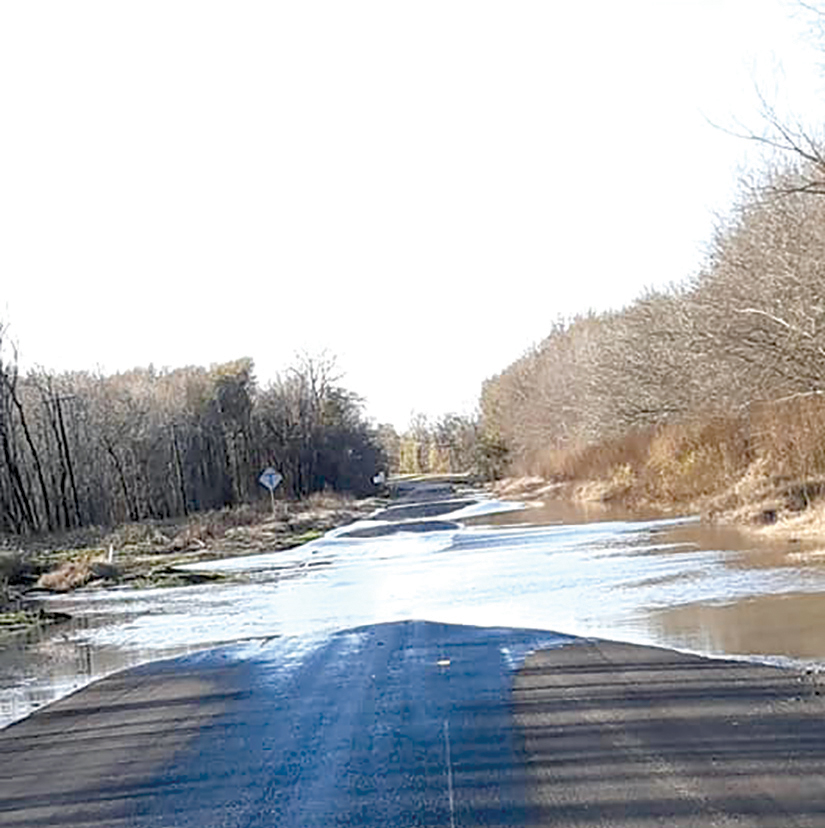Stakeholders discuss cost, environment

Infrastructure
The State Highway 71 bridge in Hopkins County flooded last weekend due to increased rainfall, and although Texas Department of Transportation Paris District took a meeting to address concerns about the bridge, involved governmental agencies stated that there was not enough money to clean out the log jam causing the flooding.
From the 24-hour period of Nov. 25 to Dec. 1 at 7 a.m., the National Weather Service data indicated that the area near the SH 71 bridge had received approximately 1-2 inches of new precipitation. On Saturday, Nov. 30, Emblem resident Marna Martinez noted that the waters of the South Sulphur River had overflowed their banks at the SH 71 bridge.
The NWS’s public safety campaign, “Turn Around, Don’t Drown” specifies it is unsafe to drive through moving water at the risk of becoming entrapped and drowning. TxDOT also urges to “avoid driving over any roads that are covered with water.”
Records from 911 call logs to HCSO noted that Delta County called at 6:37 p.m. on Saturday to report “high water, unpassable” at the SH 71 bridge on the Delta County line.
“Passable or not, I wouldn’t drive through it,” Martinez said, “because the water is rising.”
On Nov. 5, TxDOT representatives along with Rep. Dan Flynn (R-Canton), members of the Northeast Texas Municipal Water District, the Sulphur River Basin Authority and members of the Army Corps of Engineers met to discuss progress on the bridge and its associated log jam which stretches from near Commerce in Hunt County almost to Cooper Lake in Delta County, affecting Hopkins County in between.
Notes produced from that meeting, taken by the water district’s water quality leader Robert Speight, show discussion centered on costs to fix the bridge and possibly the jam itself.
According to TxDOT representatives, the bridge, which was built in 1962, passed most recent inspection and rates highly enough structurally that it is not a candidate for replacement using federal dollars. The bridge “would have to be built to span the floodplain” and TxDOT estimated it would be 1.1 miles long at a cost of approximately $20 million dollars.
TxDOT noted that repairing the bridge would “not fix the logjam problem, only the traffic problem,” and related that the current route to detour around SH 71 during flooding is approximately 20 miles. According to TxDOT the traffic the bridge sees is 375 vehicles a day with 15% being semi-trucks. Martinez told the News-Telegram in October she thinks the bridge sees more traffic than that, as the day before the traffic was measured, the bridge was closed.
The U.S. Army Corps of Engineers also noted funding concerns regarding the bridge and its floodplain. USACE stated it “does not have [the] budget to clean out [the] log jam” and cannot use funds from Lake Chapman upstream to fix the problem. According to Speight’s notes, USACE “does not feel it has [the] responsibility to maintain the channel even though they dredged it initially as part of Chapman project” and “Cited building levees and then turning them over to locals to maintain” as the reasoning for this belief.
Ultimately, the USACE would need Congressional authorization to divert funds to the project and “cannot seek funding without justification” and a plan that other agencies such as the Texas Parks and Wildlife Department, the U.S. Fish and Wildlife Service and the Environmental Protection Agency could approve.
Speight noted that US-ACE “does not see this passing muster from a cost/ benefit analysis.”
According to Speight’s notes, Flynn’s office “Opines that the Corps created the problem when it dredged [the area], and they should not be able to deny responsibility for the damage their asset is causing.”
The SRBA’s Mike But-tram agreed, stating the “Corps caused the problem with channelization and ask[ed] if they [USACE] can do a study on how to fix it and [how to] restore the original meander of the stream.”
However, USACE underscored they could not undertake a study without a local partner.
Several environmental agencies, including the Texas Commission on Environmental Quality (TECQ) and TPWD stated they would have concerns with the removal of logs and/ or dredging or re-routing the water, as such actions could have environmental impacts.
Hopkins County Judge Robert Newsom told the group he was most concerned about safety.
“My opinion is TxDOT and USACE seem to have no interest or desire to work toward a solution,” Martinez stated. “TXxDOT implied those who would be paying were the shareholders. We as citizen taxpayers … are shareholders.”

